
Table of Contents[Hide][Show]
As humans, we live in a world where constant movement and forward progression is desired, and that feeling is no different for our sweet pets. Watch any dog and you’ll see a flurry of continuous motion. It’s one of the reasons dog wheelchairs are so popular. It’s also the reason why we need to keep dogs in wheelchairs safe.
Paraplegic pets are having more accidents in their carts, than ever before. The life-saving device that’s given mobility back to so many canines is also the cause of serious and sometimes fatal injuries. But with some common sense practices, we can help our pets keep moving for a long time.
The importance of dog wheelchair safety
Not long ago, I interviewed a pet owner whose dog had a birth defect that left her paralyzed. He spent an hour talking about her and how proud he was with the progress she had made. When we ended our conversation, it felt like I had made a new friend. I told him I would let him know when the article was done.
The story was never published because the puppy died that afternoon. She was running around in her wheels when she accidently fell into the swimming pool and drowned. The accident could’ve happened to anyone.
This sad experience made me realize that a story about wheelchair safety and maintenance, had to be shared.
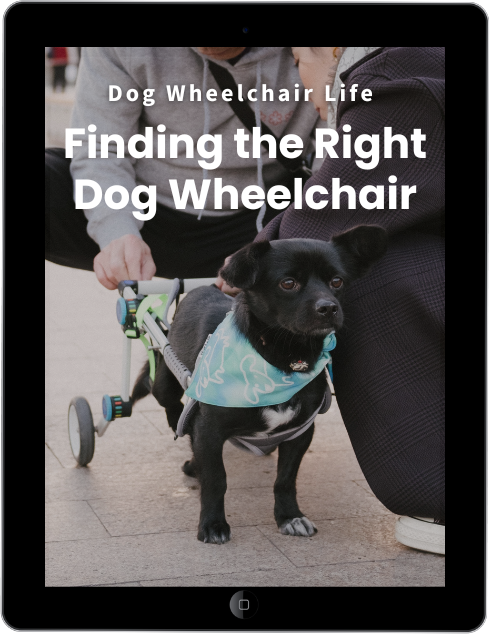
eBook
Find The Right Dog Wheelchair For Your Pet
Your dog has a mobility problem, and you want to buy a wheelchair. But do you know what kind of cart will work best for your dog’s individual needs? After a decade of teaching pet owners how to make the right choice, I put the information into an eBook!
Learning about the risks
To research this article, I turned to pet parents who participate in the Dog Wheelchair LIFE Facebook group. From their experiences, I discovered 8 categories where dogs run into trouble.
These categories are:
- Wheelchairs that don’t fit well
- Inexperienced wheelers
- Too many flips
- Lack of supervision
- The health of the dog is overestimated
- Hit and run-ins
- Stairs and steps
- Poor cart maintenance
Wheelchairs that don’t fit
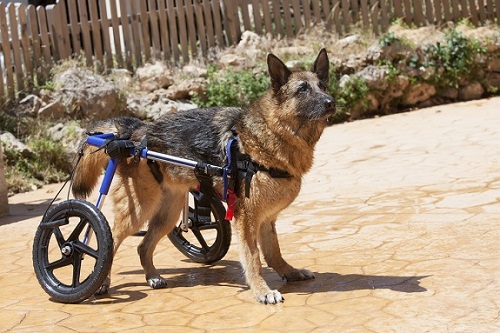
The right fit makes a world of difference in keeping a dog safe from injuries. That means the cart needs to be the correct size (height, width and length) and the right weight (heavy enough) for your pup. It also has to fit the shape of your dog’s body.
These important factors are why many people turn to custom dog wheelchair companies. They build a cart for your individual pet. It’s also why ready-made manufacturers have started to design wheels for specific breeds. The right fit of a cart has to accommodate factors like the stocky frame and short legs of a Corgi and the long torso of Dachshund.
If a cart doesn’t fit well, there’s more opportunity for an accident.
Things to look for
- Overall Size
- If there’s an arch in a dog’s back, the cart probably isn’t big enough.
- Leg Straps
- Be sure to check how the leg straps on the wheelchair fit. They can be a health risk if they fit too loose or too tight. Loose straps cause your dog to drag their paws on the ground while tight straps can rub them raw.
Kathleen Smiler, DVM, founder of Pug Myelopathy, recommends that a veterinarian “credentialed in rehabilitation” be consulted to appraise the fit and suitability of the cart, whenever possible.
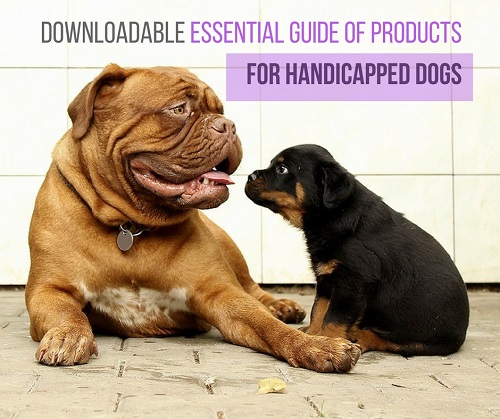
Get the Essential Guide
The Essential Guide of Products for Handicapped Dogs e-book is a labor of love for me. I wrote it to answer your most pressing questions about where to find the best products for your wheelchair dog. You’ll find products you didn’t know existed and each will improve your dog’s quality of life. Print a copy and keep it by your side.
Other factors
The importance of having a cart that fits well also causes concern for DIY wheelchairs. If you’re going to use one, make sure it meets all of the criteria stated above.
Inexperienced wheelers

We all have a learning curve when it comes to new experiences and life adjustments. It’s no different for our pets.
Slow, but Steady – A Winning Approach
Some dogs love their carts from the minute they get in them, while other dogs need time to adjust. If your dog is hesitant, it’s important to start with short 5–10-minute sessions in the wheelchair. This helps an animal build their confidence.
Ready to roll
On the other hand, if your dog jumps in their cart the first time, ready to roll, be prepared for all possible outcomes. Your inexperienced wheeler will need your full attention to prevent a mishap.
Be sure to keep your pup on a leash and in a contained area for the first few rides. This will give you as much control as possible. Your new wheelchair dog has a lot to learn like how to maneuver over uneven surfaces and when to stop for an oncoming car.

My favorite harnesses for disabled dogs.
Words from pet owners
Susan H. said her dog took off running and knocked her down, the first time in a cart. She had to run after the dog to prevent an accident. And pet mom Maria Elena explained how her dog Daisy chased after a squirrel and nearly flipped the wheelchair.
Top safety concerns for novice wheelers
The most common safety risk for wheelchair dogs is flipping over. Of the more than 30 owners who shared their advice for this post, nearly everyone talked about their dog flipping their cart at least once.
Most of the time, these rollovers weren’t life-threatening. However, one pet owner, shared how her dog flipped his cart so hard that he fell on his back, reinjuring himself.
Dog wheelchairs flip for a variety of reasons. Some dogs don’t have a good sense of the width of their cart. They flip entering and exiting rooms and while making turns. Other dogs have rollovers when they take a sharp turn or lose control from running too fast.
Dogs also flip over when their cart is too light for their bodyweight. Be sure to select a wheelchair that’s the proper weight and sturdy enough for your pup.
Walkin’ Wheels offers a tool to help owners choose the right size cart. It’s called the SureFit™ Calculator and it takes pet owners through a series of questions about your dog’s height and weight, breed and the length of their legs.
Here are a few real-life flipping accidents:
- One dog flipped while trying to go through the doorway. He hadn’t learned how to find the center of the entryway while using his cart.
- Another pup hiked across a river with his owner. The flowing water caused him to flip. Luckily his pet mom was by his side to help.
- A pet mom shared how running down a hill caused her dog to flip the wheelchair. The pup rolled multiple times before the cart stopped.
- Another dog flipped a cart because she didn’t see an object in her path.
Lack of supervision
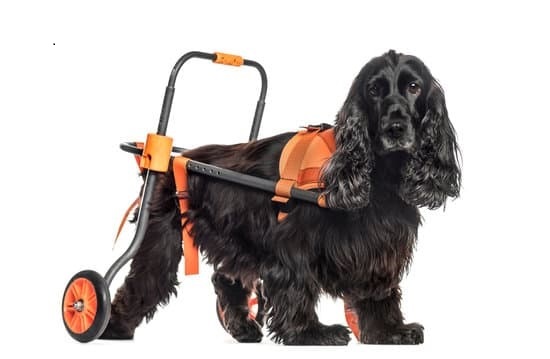
Dogs need constant supervision. Never leave your dog alone in their cart. It’s also important to note at this point, that wheelchairs are meant for specific mobility activities like exercise, walks and playtime. Dogs should not wear them 24 hours a day.
Most dogs can’t lie down in their wheelchair, so they need time out of it to rest. Being in a cart puts added stress on your pet’s front legs and paws. This can cause an injury. Use wheelchairs for activities and not as a replacement for their paralyzed limbs.
Why you should manage every excursion
- Paralyzed dogs love to chase – Like able-bodied pets, paralyzed dogs love to run after rodents, other dogs and the FedEx truck. If they aren’t supervised, they can easily be injured.
- Drownings – As more dogs take part in hydrotherapy and under water treadmills, they’re becoming relaxed around bodies of water like your swimming pool or a lake. Some dogs wander into the water in their cart without realizing they can’t get out. Keep pools fenced and off- limits without supervision.
- Dog wheelchairs get stuck – Mighty Max is a paralyzed pup who routinely backs his cart into spaces where it won’t fit. He’s been known to knock over furniture trying to get free. Another dog named Levi got stuck wheeling over the on the uneven terrain around his house. A wheel on his cart got caught so badly, his pet mom had to remove it to pull Levi free.
- Running over curbs – A sweet dog named Maisy flipped her cart after walking off a street curb. Dogs don’t realize a wheelchair doesn’t work well with curbs or steps.
- Tails can get caught – One pet mom reported that her dog’s long tail got wrapped in the wheels of his chair. The dog had to be cut loose.
- Paws can get caught – Jax ran so fast in his wheelchair that the momentum pulled his leg strap loose and his foot got caught in one of the wheels. It took several minutes to cut the strap.
The health of a dog is overestimated
Using a dog wheelchair is hard physical work for your pup. So, it’s important to be aware of their overall health and stamina. Paraplegic pets are not just dogs who walk with wheels, they’re canines with a health deficit. Straining their bodies can lead to accidents.
It’s important to discuss your dog’s capabilities and limitations with your veterinarian before resuming normal activities.
One example is an accident that happened when a pet owner overestimated how far his dog could run, during a hunting trip. The dog took off running after a duck, like he had always done, but he grew tired pulling his cart behind him. He tripped over a branch and flipped the wheelchair hard. It broke the dog’s spine.
Hit and run-ins
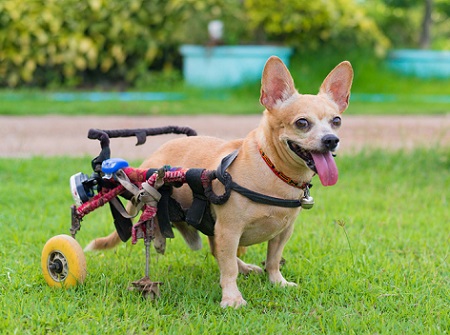
Another benefit of keeping your dog safe in their wheelchair is that it protects the people around your pet. More than one owner shared a story about their dog running into a child or someone passing by.
- A dog named Stagger Lee nearly ran over his little sister pup. He loved running as fast as he could in his cart but needed to learn to slow down when he came close to the small dog in the family.
- Another dog ran around in his cart so quickly that he caught the leg of another dog in the wheel.
If your family includes with multiple pets or small children, work with your dog to keep a safe distance and to slow down when someone was nearby. You might have to leash your pup at first or remind them to “leave it” if they come too close.
Stairs and steps
Dog wheelchairs are not meant to be used on stairs and steps. Your dog might be an expert in a cart, but even one step can lead to an accident. If you have stairs, try using a support harness to help your dog climb up and down. And if there’s a step leading outside, manually assist your dog or add a ramp, rather than letting them use their cart.
Pet mom Morgan said that it broke her heart to watch her dog flip over in her cart after trying to maneuver a single step in their home.
Click here to read: How to Choose the Right Support Harness
Maintain your cart like a well-oiled machine
![walkin-all-pet-products[1]](https://dogwheelchairlife.com/wp-content/uploads/2020/12/walkin-all-pet-products1.jpg)
Wheelchairs need maintenance. Tires wear out and bolts come loose. Make sure you examine your cart regularly and take care of repairs as needed. Some dog wheelchair companies offer annual maintenance plans, and every wheelchair company sells replacement parts for you to install.
One smart pet dad found a local bike shop to work on his dog’s cart.
They changed the tires, greased the bearings and gave the cart a once-over looking for signs of wear. At home, I tighten the screws once a month.
Wheelchairs are a tool
Wheelchairs are safe devices for most paralyzed dogs. This article isn’t intended to keep you from giving this wonderful gift to your pet. It’s meant to provide you with common sense tips that will keep your dog mobile and happy for a long time.
Interested in more information? Try our new ebook: HOW TO CHOOSE THE RIGHT DOG WHEELCHAIR


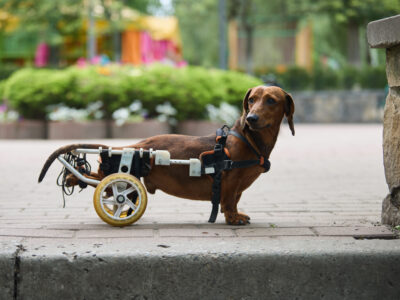
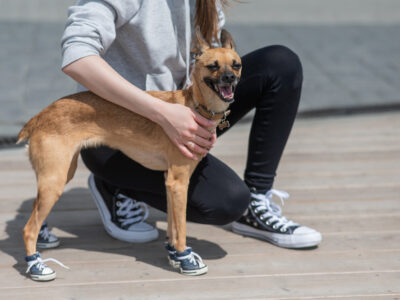

Hi I’m desperately in need of a wheel chair for my 15yo dachshund he suffers from Ivdd
I can not afford to buy one and I was curious if you new a place that could help me ? Please get back to me ASAP
Thank you so much
Hi Ashley, I’m sorry to hear about your dachshund. I have a complete article about the nonprofit groups who donate dog wheelchairs to pet families. Here’s the link: https://dogwheelchairlife.com/organizations-that-donate-dog-wheelchairs-to-pet-families/ The story explains the criteria each organization has for a donated cart and when you find one that meets your needs, click on the blue highlighted words and it will take you directly to the group’s application page. It’s a quick and easy process. – Sharon
I have bought a shell hair for my 12 year old 40 kilo German shepherd
He doesn’t seem to like it
I have concerns as his testes are being squished in between the two black rubber rings that hold up and support his back legs
It looks so uncomfortable
I contacted the manufacturer but was just told to pull down the little ring that joins the two ri gs together which doesn’t help at all Have you heard of anyone having a similar problem with entire males and the placement of their testes in a wheelchair Thank you
Some owners add padding, like a piece of sheepskin or wool to make the saddle softer. Your problem could also be a sign that the saddle is the wrong size for your dog.